HBS108 Task 2: Interpreting Health Evidence - Activity & Mental Health
VerifiedAdded on 2023/04/22
|8
|1807
|423
Report
AI Summary
This report provides a comprehensive appraisal of three medical articles focusing on the relationship between physical activity and mental health, particularly among adolescents. It examines study designs, measurement scales, and odds ratios, delving into potential biases and the significance of various findings. The review covers a cross-sectional study on leisure-time physical activity and mental health symptoms, a qualitative study on exercise for adolescents with depression, and a cluster RCT on promoting healthy lifestyles in high schools. The analysis identifies researcher and outcome biases, discusses the use of Likert scales, and evaluates the internal and external validity of the studies. Ultimately, the report synthesizes the evidence to propose a health promotional policy aimed at improving the physical and mental health of young people through increased physical activity and cognitive counseling.
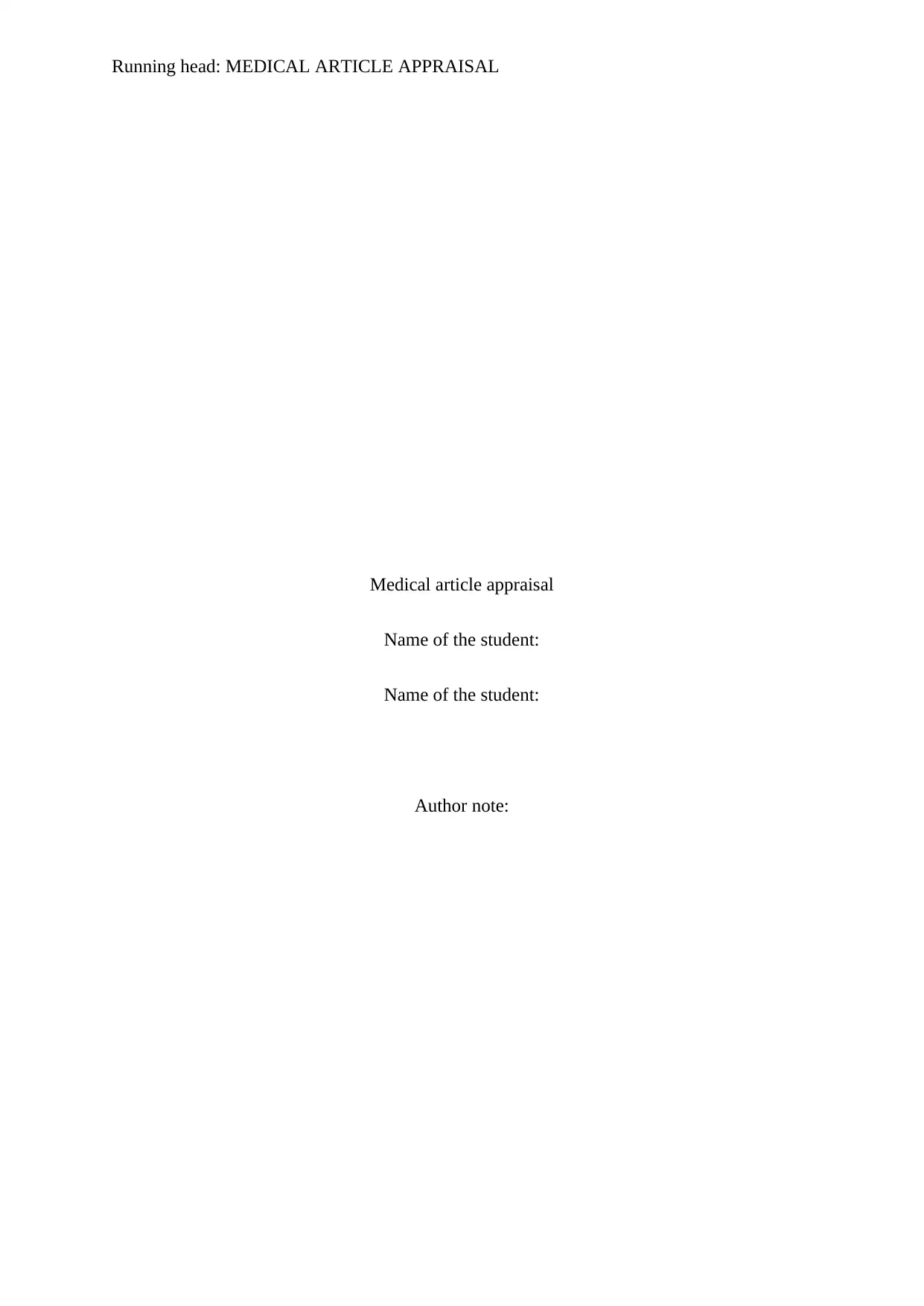
Running head: MEDICAL ARTICLE APPRAISAL
Medical article appraisal
Name of the student:
Name of the student:
Author note:
Medical article appraisal
Name of the student:
Name of the student:
Author note:
Paraphrase This Document
Need a fresh take? Get an instant paraphrase of this document with our AI Paraphraser

1
MEDICAL ARTICLE APPRAISAL
Table of Contents
Task A........................................................................................................................................2
Task B:.......................................................................................................................................3
Task C:.......................................................................................................................................4
Task D:.......................................................................................................................................6
References:.................................................................................................................................7
MEDICAL ARTICLE APPRAISAL
Table of Contents
Task A........................................................................................................................................2
Task B:.......................................................................................................................................3
Task C:.......................................................................................................................................4
Task D:.......................................................................................................................................6
References:.................................................................................................................................7
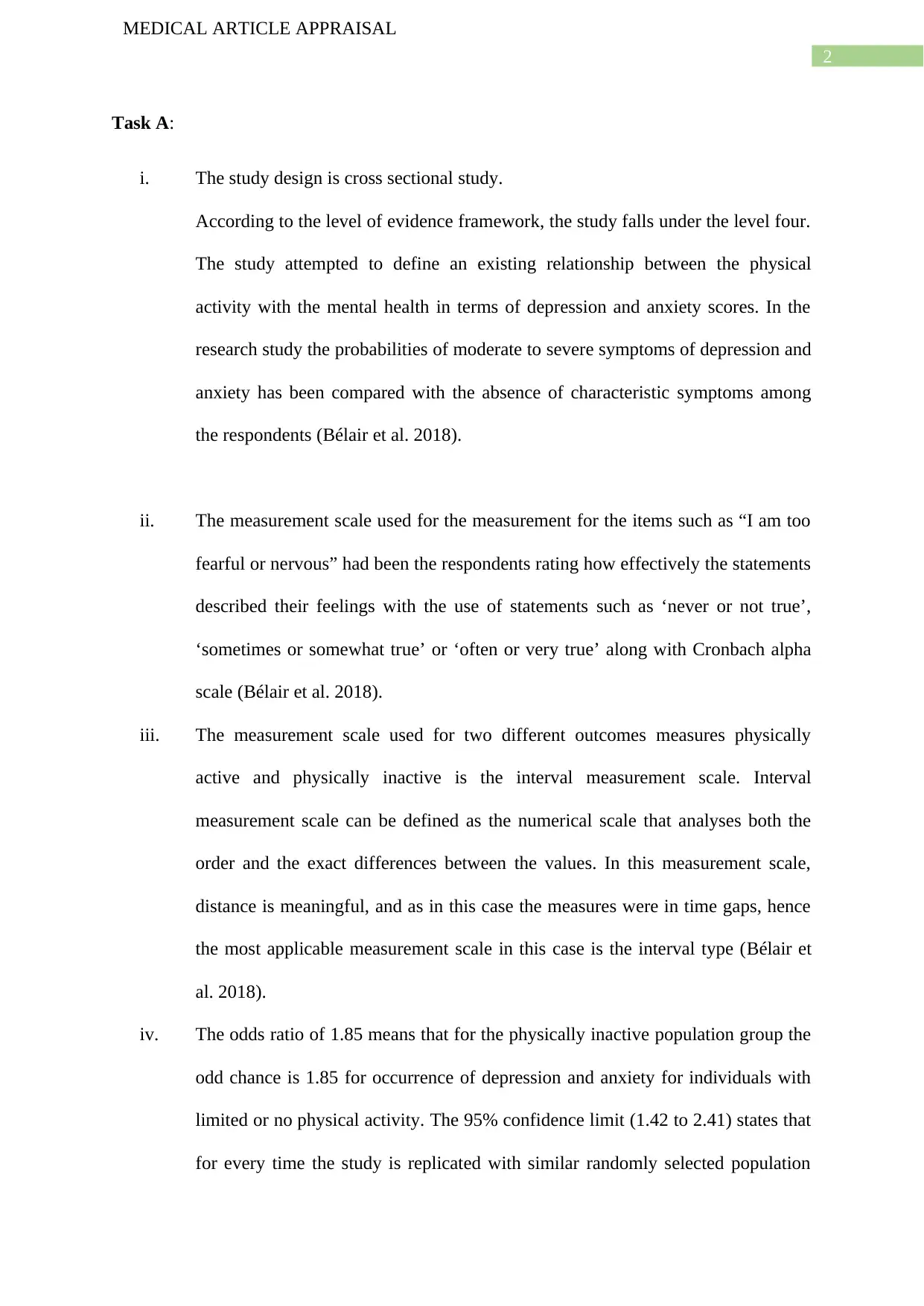
2
MEDICAL ARTICLE APPRAISAL
Task A:
i. The study design is cross sectional study.
According to the level of evidence framework, the study falls under the level four.
The study attempted to define an existing relationship between the physical
activity with the mental health in terms of depression and anxiety scores. In the
research study the probabilities of moderate to severe symptoms of depression and
anxiety has been compared with the absence of characteristic symptoms among
the respondents (Bélair et al. 2018).
ii. The measurement scale used for the measurement for the items such as “I am too
fearful or nervous” had been the respondents rating how effectively the statements
described their feelings with the use of statements such as ‘never or not true’,
‘sometimes or somewhat true’ or ‘often or very true’ along with Cronbach alpha
scale (Bélair et al. 2018).
iii. The measurement scale used for two different outcomes measures physically
active and physically inactive is the interval measurement scale. Interval
measurement scale can be defined as the numerical scale that analyses both the
order and the exact differences between the values. In this measurement scale,
distance is meaningful, and as in this case the measures were in time gaps, hence
the most applicable measurement scale in this case is the interval type (Bélair et
al. 2018).
iv. The odds ratio of 1.85 means that for the physically inactive population group the
odd chance is 1.85 for occurrence of depression and anxiety for individuals with
limited or no physical activity. The 95% confidence limit (1.42 to 2.41) states that
for every time the study is replicated with similar randomly selected population
MEDICAL ARTICLE APPRAISAL
Task A:
i. The study design is cross sectional study.
According to the level of evidence framework, the study falls under the level four.
The study attempted to define an existing relationship between the physical
activity with the mental health in terms of depression and anxiety scores. In the
research study the probabilities of moderate to severe symptoms of depression and
anxiety has been compared with the absence of characteristic symptoms among
the respondents (Bélair et al. 2018).
ii. The measurement scale used for the measurement for the items such as “I am too
fearful or nervous” had been the respondents rating how effectively the statements
described their feelings with the use of statements such as ‘never or not true’,
‘sometimes or somewhat true’ or ‘often or very true’ along with Cronbach alpha
scale (Bélair et al. 2018).
iii. The measurement scale used for two different outcomes measures physically
active and physically inactive is the interval measurement scale. Interval
measurement scale can be defined as the numerical scale that analyses both the
order and the exact differences between the values. In this measurement scale,
distance is meaningful, and as in this case the measures were in time gaps, hence
the most applicable measurement scale in this case is the interval type (Bélair et
al. 2018).
iv. The odds ratio of 1.85 means that for the physically inactive population group the
odd chance is 1.85 for occurrence of depression and anxiety for individuals with
limited or no physical activity. The 95% confidence limit (1.42 to 2.41) states that
for every time the study is replicated with similar randomly selected population
⊘ This is a preview!⊘
Do you want full access?
Subscribe today to unlock all pages.

Trusted by 1+ million students worldwide

3
MEDICAL ARTICLE APPRAISAL
the confidence interval for 95% of the sample would include the parametric mean
(Neuman 2016).
v. The odds ratio for physically inactive people developing depression and anxiety
was 1.85 whereas the odds ratio for sedentary lifestyle had been 1.26, which
indicates whereas no physical activity causes higher depression and anxiety
symptoms, sedentary activity which should have had higher rate was confusingly
low. Moreover, the odds ratio for the sedentary activity only model as well as the
the joint model were calculated to be close, being 1.31 and 1.26, which further
indicated a lack of statistical significance for the comparison (Bélair et al. 2018).
Hence, the associations between sedentary behaviour and depressive symptoms
are not clearly evident.
vi. Stressful life events such as trauma, bereavement or loss can elicit a negative
impact on lifestyle and mental health status of the individual. Hence, even with a
highly physically active lifestyle, the mental health could still be affected.
vii. This study concluded that absence of any form of physical activity and a sedentary
lifestyle poses a high risk of developing depression and anxiety. Hence, especially
among the youth, the impact of an inactive or sedentary life can result in very
limited exposure to outer world which in turn can reduce the mental health and
pave way for depressive disorders or anxiety (Bélair et al. 2018).
Task B:
i. One very important bias that can be associated with this scenario is the researcher bias. This
study has utilized the purposeful sampling which is very prone to researcher bias and as
the selection of sampling is based on the researcher completely, there is risk of conscious
or unconscious bias (Howe et al. 2016). The second type of bias is the outcome bias
MEDICAL ARTICLE APPRAISAL
the confidence interval for 95% of the sample would include the parametric mean
(Neuman 2016).
v. The odds ratio for physically inactive people developing depression and anxiety
was 1.85 whereas the odds ratio for sedentary lifestyle had been 1.26, which
indicates whereas no physical activity causes higher depression and anxiety
symptoms, sedentary activity which should have had higher rate was confusingly
low. Moreover, the odds ratio for the sedentary activity only model as well as the
the joint model were calculated to be close, being 1.31 and 1.26, which further
indicated a lack of statistical significance for the comparison (Bélair et al. 2018).
Hence, the associations between sedentary behaviour and depressive symptoms
are not clearly evident.
vi. Stressful life events such as trauma, bereavement or loss can elicit a negative
impact on lifestyle and mental health status of the individual. Hence, even with a
highly physically active lifestyle, the mental health could still be affected.
vii. This study concluded that absence of any form of physical activity and a sedentary
lifestyle poses a high risk of developing depression and anxiety. Hence, especially
among the youth, the impact of an inactive or sedentary life can result in very
limited exposure to outer world which in turn can reduce the mental health and
pave way for depressive disorders or anxiety (Bélair et al. 2018).
Task B:
i. One very important bias that can be associated with this scenario is the researcher bias. This
study has utilized the purposeful sampling which is very prone to researcher bias and as
the selection of sampling is based on the researcher completely, there is risk of conscious
or unconscious bias (Howe et al. 2016). The second type of bias is the outcome bias
Paraphrase This Document
Need a fresh take? Get an instant paraphrase of this document with our AI Paraphraser
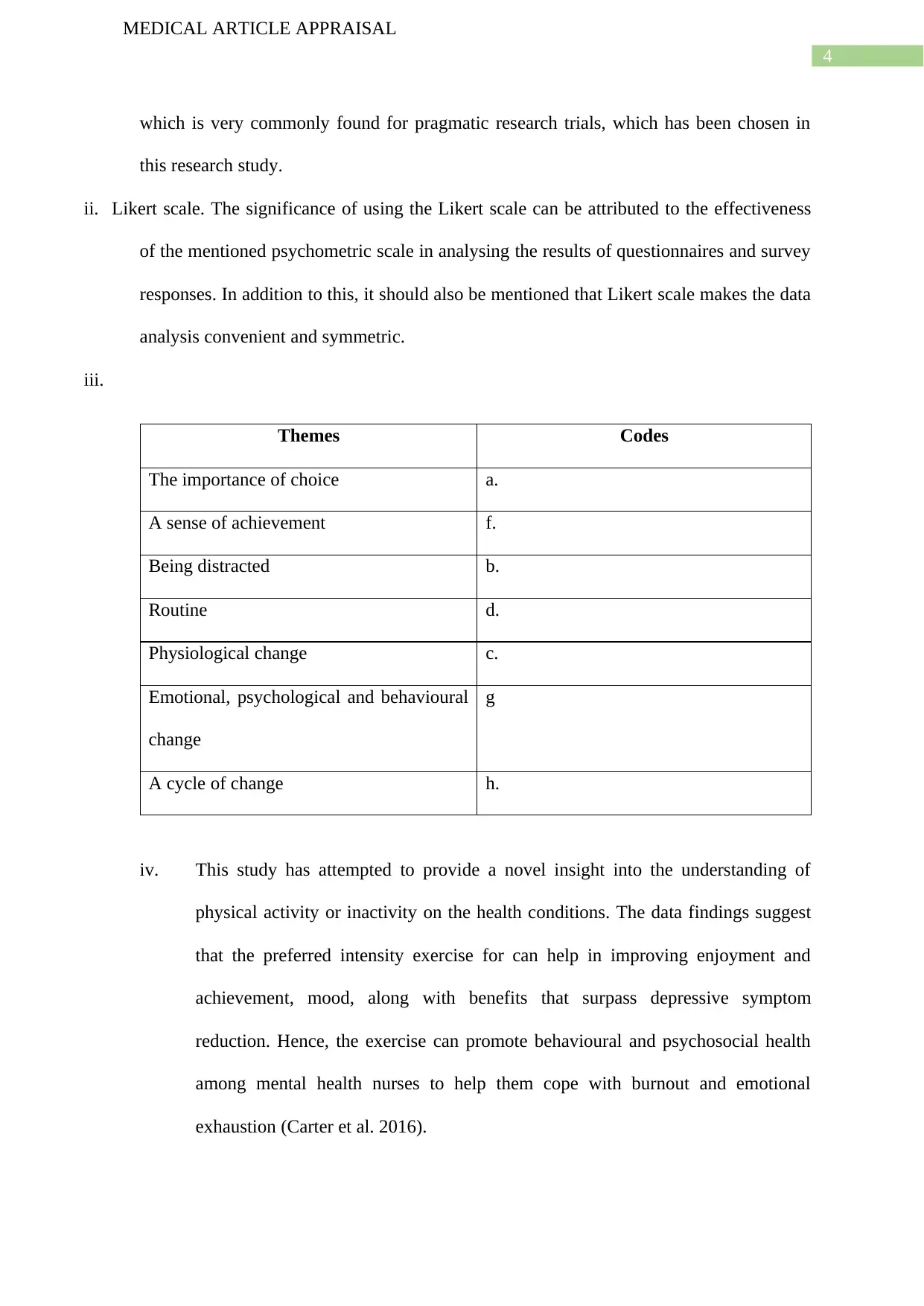
4
MEDICAL ARTICLE APPRAISAL
which is very commonly found for pragmatic research trials, which has been chosen in
this research study.
ii. Likert scale. The significance of using the Likert scale can be attributed to the effectiveness
of the mentioned psychometric scale in analysing the results of questionnaires and survey
responses. In addition to this, it should also be mentioned that Likert scale makes the data
analysis convenient and symmetric.
iii.
Themes Codes
The importance of choice a.
A sense of achievement f.
Being distracted b.
Routine d.
Physiological change c.
Emotional, psychological and behavioural
change
g
A cycle of change h.
iv. This study has attempted to provide a novel insight into the understanding of
physical activity or inactivity on the health conditions. The data findings suggest
that the preferred intensity exercise for can help in improving enjoyment and
achievement, mood, along with benefits that surpass depressive symptom
reduction. Hence, the exercise can promote behavioural and psychosocial health
among mental health nurses to help them cope with burnout and emotional
exhaustion (Carter et al. 2016).
MEDICAL ARTICLE APPRAISAL
which is very commonly found for pragmatic research trials, which has been chosen in
this research study.
ii. Likert scale. The significance of using the Likert scale can be attributed to the effectiveness
of the mentioned psychometric scale in analysing the results of questionnaires and survey
responses. In addition to this, it should also be mentioned that Likert scale makes the data
analysis convenient and symmetric.
iii.
Themes Codes
The importance of choice a.
A sense of achievement f.
Being distracted b.
Routine d.
Physiological change c.
Emotional, psychological and behavioural
change
g
A cycle of change h.
iv. This study has attempted to provide a novel insight into the understanding of
physical activity or inactivity on the health conditions. The data findings suggest
that the preferred intensity exercise for can help in improving enjoyment and
achievement, mood, along with benefits that surpass depressive symptom
reduction. Hence, the exercise can promote behavioural and psychosocial health
among mental health nurses to help them cope with burnout and emotional
exhaustion (Carter et al. 2016).

5
MEDICAL ARTICLE APPRAISAL
Task C:
i. Cluster RCT.
Internal validity refers to the quality of the experiment and how it is completed,
especially with avoiding confounders (Palinkas et al. 2015). In this case, as this is
a cluster RCT study, the Random allocation of schools as compared to individual
classrooms to the different study group was conducted. This was done to avoid the
chances of cross-group and contamination between students within the same
school which would have eventually threatened the study’s internal validation.
As 11 high schools from two school districts in the south-western U.S were
selected in the sampling, the chances of external validity is high.
ii. The independent variables include COPE, the cognitive–behavioural skill-building
intervention coupled with 20 minutes of physical activity (Melnyk et al. 2013).
The dependent variables include healthy lifestyle behaviors and BMI.
iii. Gender (male), ethnicity, race (Asian, Black, White), CDC BMI categories
(Underweight, Healthy weight), and Steps per day are factors that showed
significant difference between two groups. A minimal 25 units or more difference
had been considered as the benchmark for considering statistically significant
(Melnyk et al. 2013).
iv. Loss to follow up represents one kind of selection bias which is very common in
cluster studies. This bias can have a string impact on reducing the internal validity
and generalizability of the research studies and reduce3 authenticity of the data
findings (Howe et al. 2016).
v. The primary aim or purpose of the study had been to research and test theshort-
and longer-term efficacy of the COPE, Healthy Lifestyles TEEN, and attention
MEDICAL ARTICLE APPRAISAL
Task C:
i. Cluster RCT.
Internal validity refers to the quality of the experiment and how it is completed,
especially with avoiding confounders (Palinkas et al. 2015). In this case, as this is
a cluster RCT study, the Random allocation of schools as compared to individual
classrooms to the different study group was conducted. This was done to avoid the
chances of cross-group and contamination between students within the same
school which would have eventually threatened the study’s internal validation.
As 11 high schools from two school districts in the south-western U.S were
selected in the sampling, the chances of external validity is high.
ii. The independent variables include COPE, the cognitive–behavioural skill-building
intervention coupled with 20 minutes of physical activity (Melnyk et al. 2013).
The dependent variables include healthy lifestyle behaviors and BMI.
iii. Gender (male), ethnicity, race (Asian, Black, White), CDC BMI categories
(Underweight, Healthy weight), and Steps per day are factors that showed
significant difference between two groups. A minimal 25 units or more difference
had been considered as the benchmark for considering statistically significant
(Melnyk et al. 2013).
iv. Loss to follow up represents one kind of selection bias which is very common in
cluster studies. This bias can have a string impact on reducing the internal validity
and generalizability of the research studies and reduce3 authenticity of the data
findings (Howe et al. 2016).
v. The primary aim or purpose of the study had been to research and test theshort-
and longer-term efficacy of the COPE, Healthy Lifestyles TEEN, and attention
⊘ This is a preview!⊘
Do you want full access?
Subscribe today to unlock all pages.

Trusted by 1+ million students worldwide
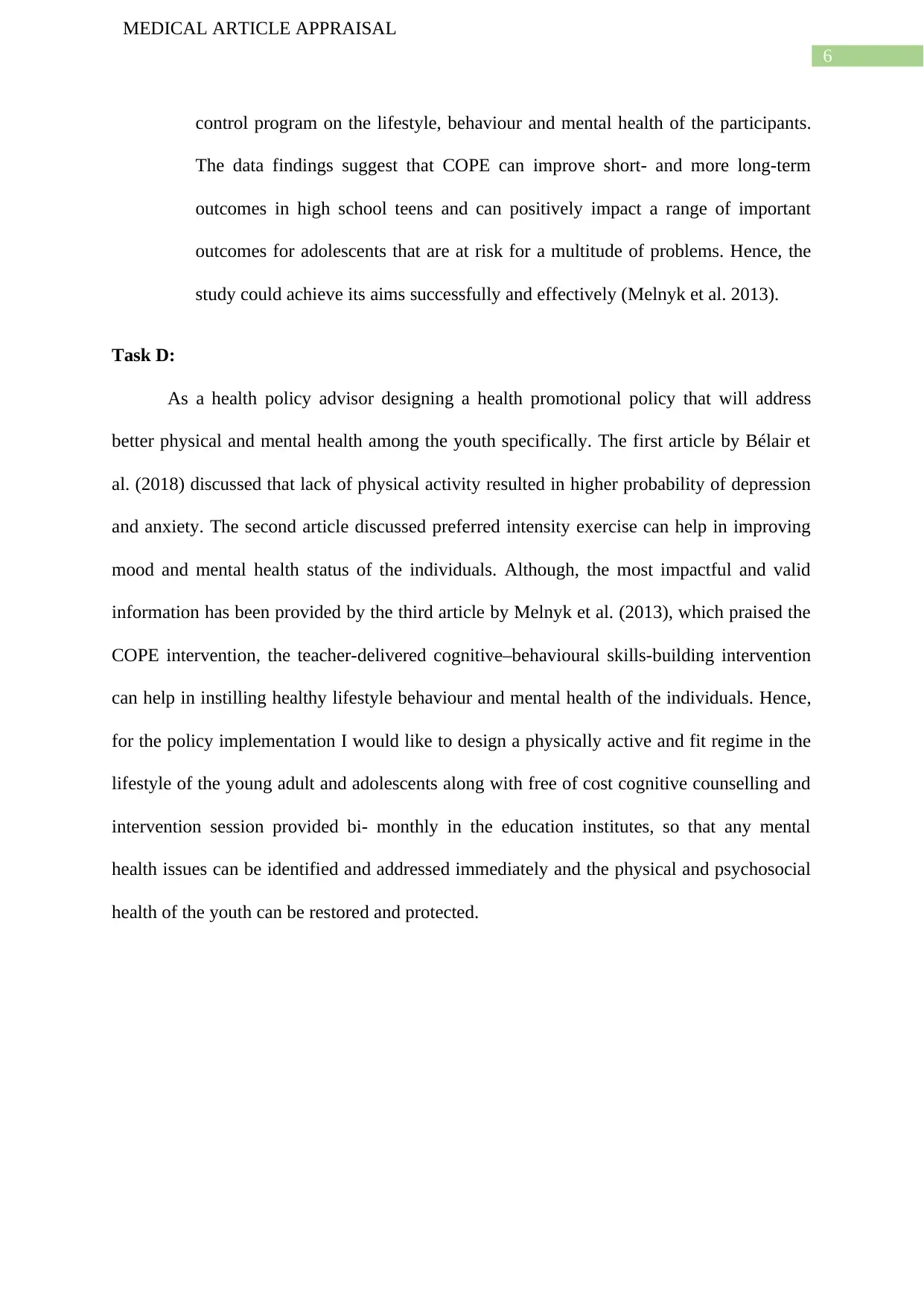
6
MEDICAL ARTICLE APPRAISAL
control program on the lifestyle, behaviour and mental health of the participants.
The data findings suggest that COPE can improve short- and more long-term
outcomes in high school teens and can positively impact a range of important
outcomes for adolescents that are at risk for a multitude of problems. Hence, the
study could achieve its aims successfully and effectively (Melnyk et al. 2013).
Task D:
As a health policy advisor designing a health promotional policy that will address
better physical and mental health among the youth specifically. The first article by Bélair et
al. (2018) discussed that lack of physical activity resulted in higher probability of depression
and anxiety. The second article discussed preferred intensity exercise can help in improving
mood and mental health status of the individuals. Although, the most impactful and valid
information has been provided by the third article by Melnyk et al. (2013), which praised the
COPE intervention, the teacher-delivered cognitive–behavioural skills-building intervention
can help in instilling healthy lifestyle behaviour and mental health of the individuals. Hence,
for the policy implementation I would like to design a physically active and fit regime in the
lifestyle of the young adult and adolescents along with free of cost cognitive counselling and
intervention session provided bi- monthly in the education institutes, so that any mental
health issues can be identified and addressed immediately and the physical and psychosocial
health of the youth can be restored and protected.
MEDICAL ARTICLE APPRAISAL
control program on the lifestyle, behaviour and mental health of the participants.
The data findings suggest that COPE can improve short- and more long-term
outcomes in high school teens and can positively impact a range of important
outcomes for adolescents that are at risk for a multitude of problems. Hence, the
study could achieve its aims successfully and effectively (Melnyk et al. 2013).
Task D:
As a health policy advisor designing a health promotional policy that will address
better physical and mental health among the youth specifically. The first article by Bélair et
al. (2018) discussed that lack of physical activity resulted in higher probability of depression
and anxiety. The second article discussed preferred intensity exercise can help in improving
mood and mental health status of the individuals. Although, the most impactful and valid
information has been provided by the third article by Melnyk et al. (2013), which praised the
COPE intervention, the teacher-delivered cognitive–behavioural skills-building intervention
can help in instilling healthy lifestyle behaviour and mental health of the individuals. Hence,
for the policy implementation I would like to design a physically active and fit regime in the
lifestyle of the young adult and adolescents along with free of cost cognitive counselling and
intervention session provided bi- monthly in the education institutes, so that any mental
health issues can be identified and addressed immediately and the physical and psychosocial
health of the youth can be restored and protected.
Paraphrase This Document
Need a fresh take? Get an instant paraphrase of this document with our AI Paraphraser
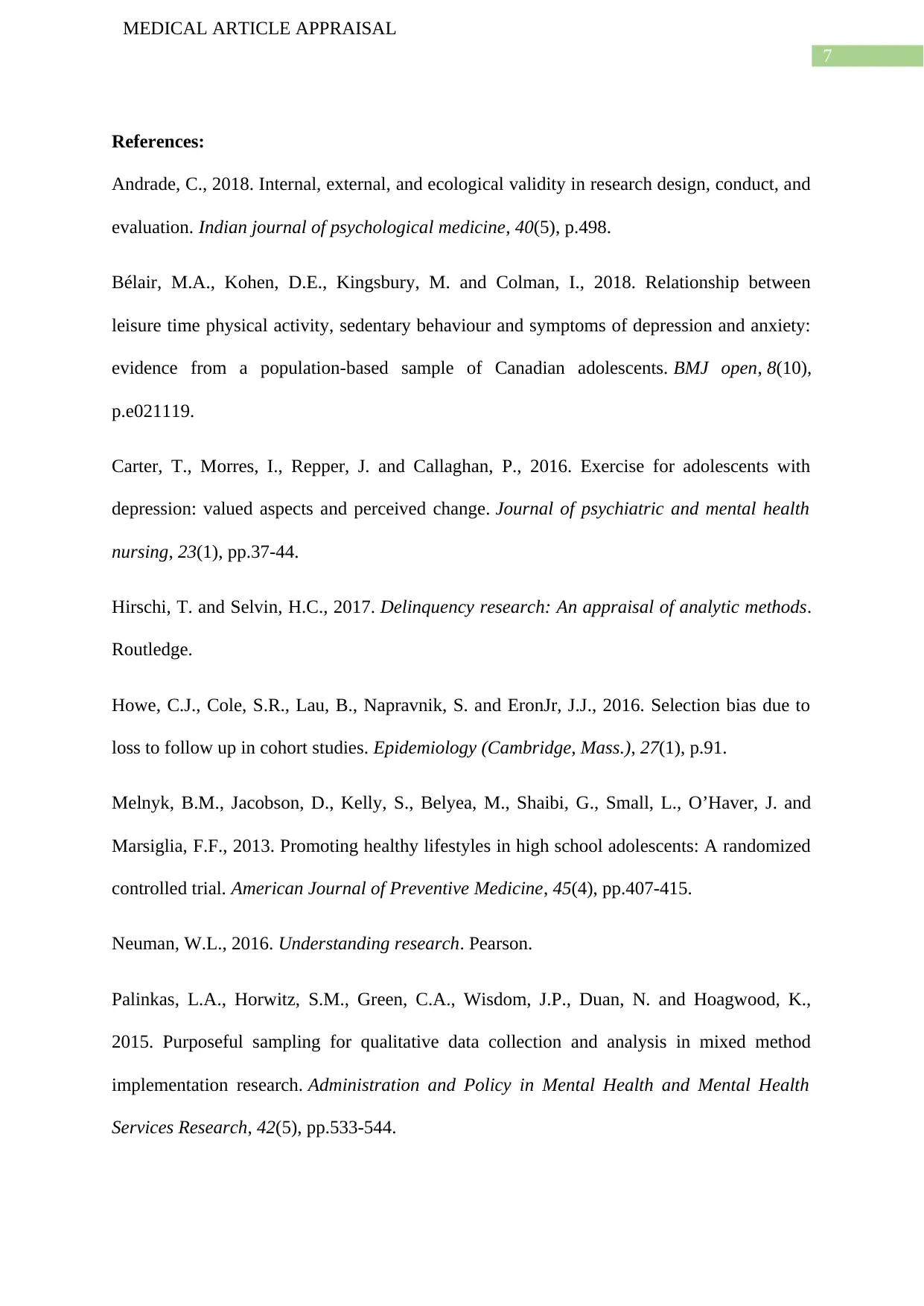
7
MEDICAL ARTICLE APPRAISAL
References:
Andrade, C., 2018. Internal, external, and ecological validity in research design, conduct, and
evaluation. Indian journal of psychological medicine, 40(5), p.498.
Bélair, M.A., Kohen, D.E., Kingsbury, M. and Colman, I., 2018. Relationship between
leisure time physical activity, sedentary behaviour and symptoms of depression and anxiety:
evidence from a population-based sample of Canadian adolescents. BMJ open, 8(10),
p.e021119.
Carter, T., Morres, I., Repper, J. and Callaghan, P., 2016. Exercise for adolescents with
depression: valued aspects and perceived change. Journal of psychiatric and mental health
nursing, 23(1), pp.37-44.
Hirschi, T. and Selvin, H.C., 2017. Delinquency research: An appraisal of analytic methods.
Routledge.
Howe, C.J., Cole, S.R., Lau, B., Napravnik, S. and EronJr, J.J., 2016. Selection bias due to
loss to follow up in cohort studies. Epidemiology (Cambridge, Mass.), 27(1), p.91.
Melnyk, B.M., Jacobson, D., Kelly, S., Belyea, M., Shaibi, G., Small, L., O’Haver, J. and
Marsiglia, F.F., 2013. Promoting healthy lifestyles in high school adolescents: A randomized
controlled trial. American Journal of Preventive Medicine, 45(4), pp.407-415.
Neuman, W.L., 2016. Understanding research. Pearson.
Palinkas, L.A., Horwitz, S.M., Green, C.A., Wisdom, J.P., Duan, N. and Hoagwood, K.,
2015. Purposeful sampling for qualitative data collection and analysis in mixed method
implementation research. Administration and Policy in Mental Health and Mental Health
Services Research, 42(5), pp.533-544.
MEDICAL ARTICLE APPRAISAL
References:
Andrade, C., 2018. Internal, external, and ecological validity in research design, conduct, and
evaluation. Indian journal of psychological medicine, 40(5), p.498.
Bélair, M.A., Kohen, D.E., Kingsbury, M. and Colman, I., 2018. Relationship between
leisure time physical activity, sedentary behaviour and symptoms of depression and anxiety:
evidence from a population-based sample of Canadian adolescents. BMJ open, 8(10),
p.e021119.
Carter, T., Morres, I., Repper, J. and Callaghan, P., 2016. Exercise for adolescents with
depression: valued aspects and perceived change. Journal of psychiatric and mental health
nursing, 23(1), pp.37-44.
Hirschi, T. and Selvin, H.C., 2017. Delinquency research: An appraisal of analytic methods.
Routledge.
Howe, C.J., Cole, S.R., Lau, B., Napravnik, S. and EronJr, J.J., 2016. Selection bias due to
loss to follow up in cohort studies. Epidemiology (Cambridge, Mass.), 27(1), p.91.
Melnyk, B.M., Jacobson, D., Kelly, S., Belyea, M., Shaibi, G., Small, L., O’Haver, J. and
Marsiglia, F.F., 2013. Promoting healthy lifestyles in high school adolescents: A randomized
controlled trial. American Journal of Preventive Medicine, 45(4), pp.407-415.
Neuman, W.L., 2016. Understanding research. Pearson.
Palinkas, L.A., Horwitz, S.M., Green, C.A., Wisdom, J.P., Duan, N. and Hoagwood, K.,
2015. Purposeful sampling for qualitative data collection and analysis in mixed method
implementation research. Administration and Policy in Mental Health and Mental Health
Services Research, 42(5), pp.533-544.
1 out of 8
Your All-in-One AI-Powered Toolkit for Academic Success.
+13062052269
info@desklib.com
Available 24*7 on WhatsApp / Email
![[object Object]](/_next/static/media/star-bottom.7253800d.svg)
Unlock your academic potential
Copyright © 2020–2025 A2Z Services. All Rights Reserved. Developed and managed by ZUCOL.

